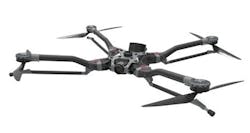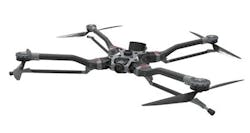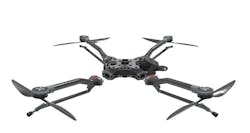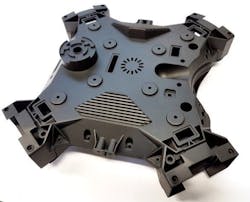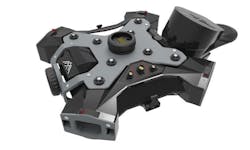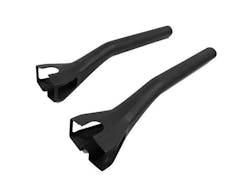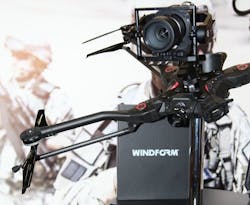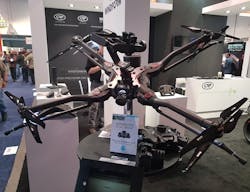Hexadrone Tundra-M modular UAS taps Windform rugged additive manufacturing materials
MOORESVILLE, N.C. Additive manufacturing or 3D printing materials originally developed for the motorsports industry by CRP Technology in Modena, Italy, and Mooresville, North Carolina, are being used to manufacture unmanned aircraft systems (UAS), commonly called drones. Engineers at CRP Technology, a CRP Group company specializing in advanced 3D printing and additive manufacturing, and Hexadrone crafted a modular UAS using Laser Sintering technology and Windform composite materials.
Engineers implemented a rugged, waterproof design to construct Hexadrone’s first fully modular, easy-to-use UAS made for extreme weather conditions and industrial and multipurpose applications. Rapidly swappable arms and three quick release attachments make the Tundra-M extremely flexible to meet the needs of any profession, while making operational conditions easier to maintain, officials say.
Suitable for different flight scenarios and professional uses, the multifunctional Tundra-M boasts four quick-connect arms and three accessory connections. The body and other main parts are made of composite polyamide-based material. Carbon-filled Windform SP and Windform XT 2.0 materials are shaped into pieces using the selective laser sintering 3D printing technology.
The four arms supporting the body frame of the Tundra were 3D printed using Windform XT 2.0 composite material. The rest of the components were developed with the Windform SP composite material.
CRP Technology, CRP Group’s specialized company in advanced 3D printing and additive manufacturing solutions, developed the Windform family of high-performance composite materials.
Understanding the limitations with traditional manufacturing technologies, the companies identified the opportunity to develop a unique UAS based on the use of additive manufacturing (AM) technologies. Additive manufacturing technologies in UAS applications has presented both opportunity and challenges to engineers in the field. The ability to produce parts and components using AM technologies hold promise in both metals and plastics, whereas traditional subtractive manufacturing technologies can be restrictive in design development and material selection.
Hexadrone officials asked CRP to devise the functional prototype of the Tundra-M, Hexadrone’s very first mass-produced drone. “We have engineered our drone by means of a cautious, multifaceted, and collaborative based approach with the involvement of broad-based stakeholders,” Hexadrone CEO Alexandre Labesse says. “In the course of two years of consulting, research, and development, we have gathered all the advice and customers’ testimonials useful to its design and which finally helped us in the process of devising an ideal UAV solution.”
Additive manufacturing is often faster than designing and producing a tool for traditional manufacturing technologies. Furthermore, 3D printing has given engineers more flexibility in the timeline to make design improvements and being able to think outside of limitations caused by traditional tooling. This choice made it possible to substantially reduce the costs and has been very convenient in terms of timing when compared to traditional production methods. The unique properties of AM Windform XT 2.0 and Windform SP composite materials enabled system optimization that withstands the design requirements due to space limitations and the extreme conditions during flights.
Hexadrone moved to SLS technology in collaboration with CRP Technology to accelerate iteration generation, improve manufacturing time, and facilitate series production.
“The Windform selective laser sintering technology allowed us to easily prototype key components of our product, to outcompete the plastic injection molding process in terms of deadlines, cost, and to test our prototype in real life conditions with almost the same mechanical characteristic,” Labesse adds. “The project we have designed with these two materials, the Windform SP and the Windform XT 2.0 from CRP Technology, lies in the conception of different frame parts, junction parts, a patented quick-release system, as well as the components forming our patented carbon-made arm system. This 3D printing time/cost saving technology helped us a lot and now allows us to calmly approach the mass production phase.”
The requirements were fast iteration process, best ratio between structural strength and weight, acceptable consistent result, and opportunity to combine multiple functionalities from one unique part. CRP Technology provided fast response time to new requirements, very good cooperation with Hexadrone and CAD designer, and best output quality with unique proprietary process, officials say.
“The most innovative aspect of Laser Sintering technology with Windform materials lies in the possibility to prototype with all the pros of the plastic injection process without the cons this method entails in terms of cost and deadlines,” Labesse says. “Furthermore, Windform provides us with a close enough material in terms of properties (e.g., density, color, tensile strength, modulus, elongation at break, etc.).”
The main stress/efforts involved in the application were:
- Compressive stress
- Tensile stress
- Vibrations
- Traction stress
The critical problem of this application resides in a lack of precision resulting in a scale gain. This gain lies between 0.15 and 0.20 millimeters. If not anticipated, this gain can compromise the assembling of the different parts as trying to fit them together.
The most interesting parts made using the Windform SP and the Windform XT 2.0 are:
- The body frame which is composed of the main frame plus a removable top lid. This component contains the brain of the Tundra-M (the main circuit boards as well as the cooling system).
“To devise this component, we were in need of a water-resistant, durable and sturdy material. Moreover, this sturdy frame comes with an emergency parachute, four removable and scalable arms, two batteries as well as three easily interfaceable accessories,” Labesse explains.
The Windform composite material used for the body frame is Windform SP due to its mechanical and thermal properties.
- The arms which are composed of motor supports plus the removable arms plus its interlock base which allows the user to easily tighten the four arms with the support of a patented “tension ring”: This stiff system allows the user to connect and disconnect the interchangeable arms on a discretionary basis.
Tundra 3D printed arms in Windform XT 2.0
The intrinsic material qualities helped to enable:
- Flight tests, which, thanks to the Windform SP and Windform XT 2.0 are run in real-world service test conditions. This application allowed the completion of successful flight tests for the Tundra-M.
- The flexibility of the Windform material and its compatibility with many different applications makes it an ideal candidate for demanding applications.
Hexadrone benefited from the plastic-like materials’ properties without the common drawbacks. The drawbacks of plastic injection molding, mainly its cost and its time consumption, make it unfit for prototyping.
Hexadrone officials selected Windform technology from CRP for the following reasons:
- The possibility to have access to printed parts within very short deadlines at a very cost-effective price.
- Windform family of composite materials can compete with the injected plastic in terms of tensile strength, stiffness, tensile modulus, elongation at break, shear strength, flexural strength, flexural modulus, traction stress vibrations, resistivity as well as density and its low moisture absorption rate.
- The price which makes Windform technology a highly profitable solution for prototyping purposes.
- The fact this method produces zero undercut as well as zero flaws which is also a good point for prototyping jobs. (Flaws are often noticeable on industrial pieces which were produced using the plastic injection method).
- Windform material density which induces a low mass making Windform an ideal component for the prototyping of UAVs and the completion of their flying tests.
Hexadrone engineers had an acute in-flight first impression as to the behavioral characteristics of the different parts processed with Windform carbon fiber-reinforced composite materials.
Hexadrone benefited from the following, officials say:
· Windform density, which makes it lightweight material suitable for unmanned aerial vehicle (UAV) prototyping phases and testing phases.
· The price, which makes it a smarter solution than plastic injection if you are to run through iterations. Plastic injection is considered financially too risky if you were to notice design flaws (In case of design flaws, the mold become obsolete and then you can’t make it profitable for the company).
· The neutral color and texture suitable for prototypes.
· The thermal properties suitable for UAV prototypes.
· The mechanical properties making it a very competitive material similar to injected plastic, in terms of the various stress an UAV has to face while flying.
· The electrical properties suitable for the prototyping of functional parts which are to be mounted in an electrical environment.
· The moisture resistance thanks to its low absorption rate suitable for the Tundra-M, an UAVs vowed to extreme weather.
The tests Hexadrone carried out on the prototype they designed using Windform reside in:
· The assembly / disassembly tests of the different parts to road test their structure as well as the fatigue resistance of this new materials.
· Landing tests, folding and unfolding the landing foot structure of the Tundra-M drone whose different structures were made in Windform SP and which support the full weight of the Tundra-M. On top of the weight of the device those small parts also have to handle the stresses due to the folding/unfolding of the landing system.
· Flight tests, to determine whether the mounted parts can handle the different strains encountered throughout the many different flight scenarios.
Tundra 3D printed functional prototype at CES 2018
Windform XT 2.0 and Windform SP are the LS polyamide-based carbon fiber reinforced Windform materials within Windform family of high-performance composite materials.
Windform XT 2.0 carbon fiber-reinforced composite 3D printing material is known for its mechanical properties. It is particularly suitable in demanding applications such as motorsports, aerospace, and UAV sectors. Windform XT 2.0 features improvements in mechanical properties including +8% increase in tensile strength, +22% in tensile modulus, and a +46% increase in elongation at break. The material allows for the creation of accurate, reliable, and durable prototypes and is perfect for functional applications.
Windform SP has excellent mechanical properties similar to Windform XT 2.0, with the addition of increased resistance to shock, vibrations, and deformation. The material also shows increases in impact strength and elongation at break, as well as excellent thermal properties and resistance to high temperatures.
Windform SP has waterproof properties, and it is resistant to absorption of liquids and moisture.
It is suitable for dyno testing and on track testing, for applications requiring resistance to impact, vibration, deformation, and high temperatures.
Windform SP is the material of choice for functional applications in motorsports, automotive (under the hood components such as intake manifolds), aerospace, and UAVs, officials say.
